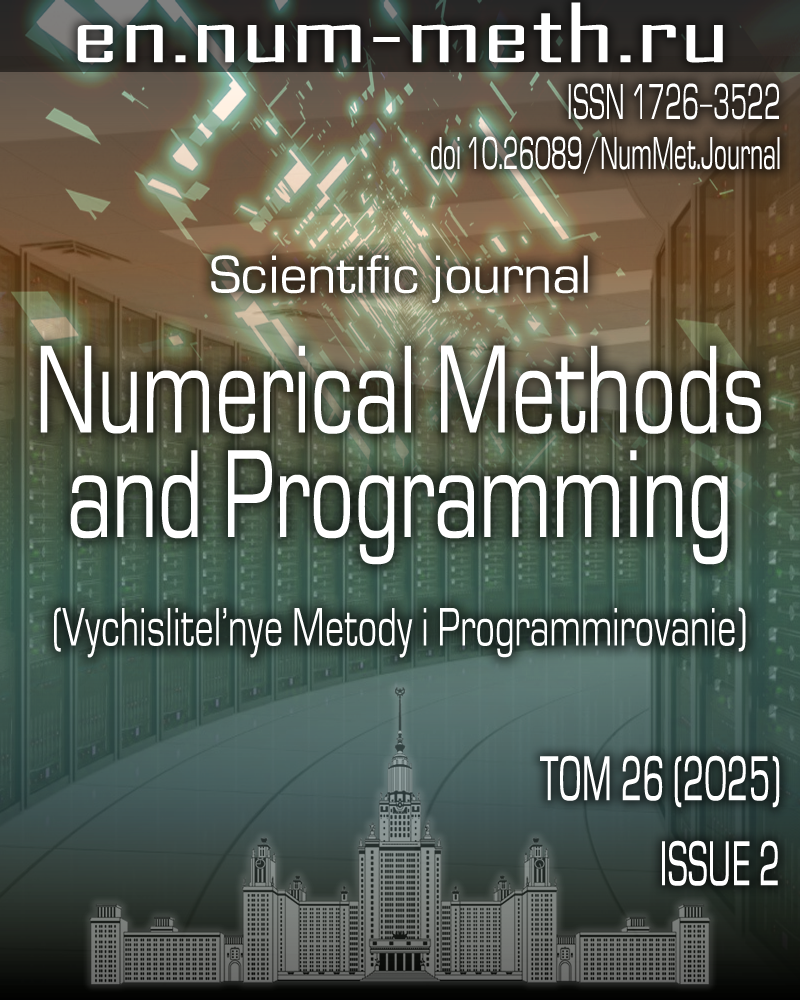DOI: https://doi.org/10.26089/NumMet.v26r207
Adaptation of Global Illumination Computation Methods Based on the Radiosity Algorithm to the Frame Graph Architecture
Keywords:
Abstract
This paper examines the integration of the radiosity method into the frame graph architecture to optimize GPU memory consumption. Methods for adapting the multi-bounce matrix method, the local matrix method, and the temporal radiosity method are proposed, considering resource management requirements on the GPU. A scheme for reusing temporal memory across different stages of global illumination processing is described, which helps reduce video memory load and minimize overhead during algorithm execution. An experimental study on test scenes confirms the effectiveness of the proposed approach and demonstrates a reduction in memory consumption.
Published
Issue
Section
References
- F. X. Sillion and C. Puech, Radiosity and Global Illumination (Morgan Kaufmann, San Francisco, 1994).
- Y. O’Donnell, FrameGraph: Extensible Rendering Architecture in Frostbite.Game Developers Conference. 2017.
https://www.gdcvault.com/play/1024612/FrameGraph-Extensible-Rendering-Architecture-in . Cited March 5, 2025. - G. Wihlidal, Halcyon: Rapid Innovation Using Modern Graphics.
https://media.contentapi.ea.com/content/dam/ea/seed/presentations/wihlidal2019-rebootdevelopblue-halcyon-rapid-innovation.pdf . Cited March 5, 2025. - R. Sandu and A. Shcherbakov, “A Resource Allocation Algorithm for a History-Aware Frame Graph,” J. WSCG 31 (1-2), 63-70 (2023).
doi 10.24132/jwscg.2023.7 - R. Sandu and A. Shcherbakov, “GPU Cache Flush Minimization in Render Graph Systems,” J. WSCG 32 (1-2), 71-78 (2024).
doi 10.24132/jwscg.2024.8 - Using Resource Barriers to Synchronize Resource States in Direct3D 12.
https://learn.microsoft.com/en-us/windows/win32/direct3d12/using-resource-barriers-to-synchronize-resource-states-in-direct3d-12 . Cited March 5, 2025. - Understanding Vulkan Synchronization.
https://www.khronos.org/blog/understanding-vulkan-synchronization . Cited March 5, 2025. - memoryBarrier(scope: after: before: ).
https://developer.apple.com/documentation/metal/mtlrendercommandencoder/memorybarrier(scope: after: before: ). Cited March 5, 2025. - C. Wyman, S. Hargreaves, P. Shirley, and C. Barré-Brisebois, Introduction to DirectX RayTracing. 2018.
https://intro-to-dxr.cwyman.org/. Cited March 5, 2025. - M. Stich, Introduction to NVIDIA RTX and DirectX Ray Tracing. 2018.
https://developer.nvidia.com/blog/introduction-nvidia-rtx-directx-ray-tracing/. Cited March 5, 2025. - C. Crassin, F. Neyret, M. Sainz, et al., Interactive Indirect Illumination Using Voxel Cone Tracing: A Preview. 2011.
doi 10.1145/1944745.1944787 - T. Ritschel, T. Grosch, and H.-P. Seidel, “Approximating Dynamic Global Illumination in Image Space,” 2009.
doi 10.1145/1507149.1507161 - J. Jimenez, X.-Ch. Wu, A. Pesce, et al., Practical Real-Time Strategies for Accurate Indirect Occlusion. 2016.
https://www.activision.com/cdn/research/Practical_Real_Time_Strategies_for_Accurate_Indirect_Occlusion_NEW Cited March 5, 2025. - A. Marrs, RTXGI: Scalable Ray Traced Global Illumination in Real Time. 2020.
https://developer.download.nvidia.com/rtx/rtxgi/NVIDIA-RTXGI-03-23-2020-v2.pdf . Cited March 6, 2025. - M. McGuire, Dynamic Diffuse Global Illumination. 2019.
https://morgan3d.github.io/articles/2019-04-01-ddgi/. Cited March 6, 2025. - Quake Lightmaps. 2015.
https://jbush001.github.io/2015/06/11/quake-lightmaps.html . Cited March 6, 2025. - R. Green, Spherical Harmonic Lighting: The Gritty Details. 2003.
https://3dvar.com/Green2003Spherical.pdf . Cited March 6, 2025. - B. Kahl, Hardware Acceleration of Progressive Refinement Radiosity Using Nvidia RTX. 2023.
https://arxiv.org/abs/2303.14831 . Cited March 6, 2025. - A. Shcherbakov, V. Frolov, and V. Galaktionov, “Virtual Patches Approach for Radiosity,” Proceedings of ISP RAS 34 (3), 47-60 (2022).
doi 10.15514/ISPRAS-2022-34(3)-4 - P. Hanrahan, D. Salzman, and L. Aupperle, “A Rapid Hierarchical Radiosity Algorithm,” Comput. Graph. 25 (4), 197-206 (1991).
- C. Damez and F. X. Sillion, “Space-Time Hierarchical Radiosity,” 1999.
https://inria.hal.science/inria-00527746/file/SpaceTimeRad.pdf . Cited March 6, 2025. - A. S. Shcherbakov and V. A. Frolov, “Matrix Transformations for Effective Implementation of Radiosity Algorithm Using Graphic Processors,” Svetotekhnika, No. 3, 43-47 (2018) [Light Eng. 27 (2), 105-110 (2019)].
doi 10.33383/2017-081 - A. Shcherbakov and V. Frolov, “Dynamic Radiosity,” Computer Science Research Notes (2019), pp. 83-90.
doi 10.24132/CSRN.2019.2901.1.10 - A. S. Shcherbakov, V. A. Frolov, and V. A. Galaktionov, Temporal Radiosity Method for 3D-Scenes of Arbitrary Detailization , Preprint No. 76 (Keldysh Institute of Applied Mathematics, Moscow, 2023).
doi 10.20948/prepr-2023-76 - A. J. Walker, “New Fast Method for Generating Discrete Random Numbers with Arbitrary Frequency Distributions,” Electronics Lett. 10 (8), 127-128 (1974).
doi 10.1049/el: 19740097. - L. Yang, S. Liu, and M. Salvi, “A Survey of Temporal Antialiasing Techniques,” Comput. Graph. Forum 39 (2), 607-621 (2020).
doi 10.1111/cgf.14018 - Temporal Super Resolution.
https://docs.unrealengine.com/5.2/en-US/temporal-super-resolution-in-unreal-engine/. Cited March 6, 2025. - H.-P. Lehmann, L. Hübschle-Schneider, and P. Sanders, “Weighted Random Sampling on GPUs,” 2021.
https://arxiv.org/abs/2106.12270 . Cited March 6, 2025.
License
Copyright (c) 2025 А. С. Щербаков

This work is licensed under a Creative Commons Attribution 4.0 International License.


